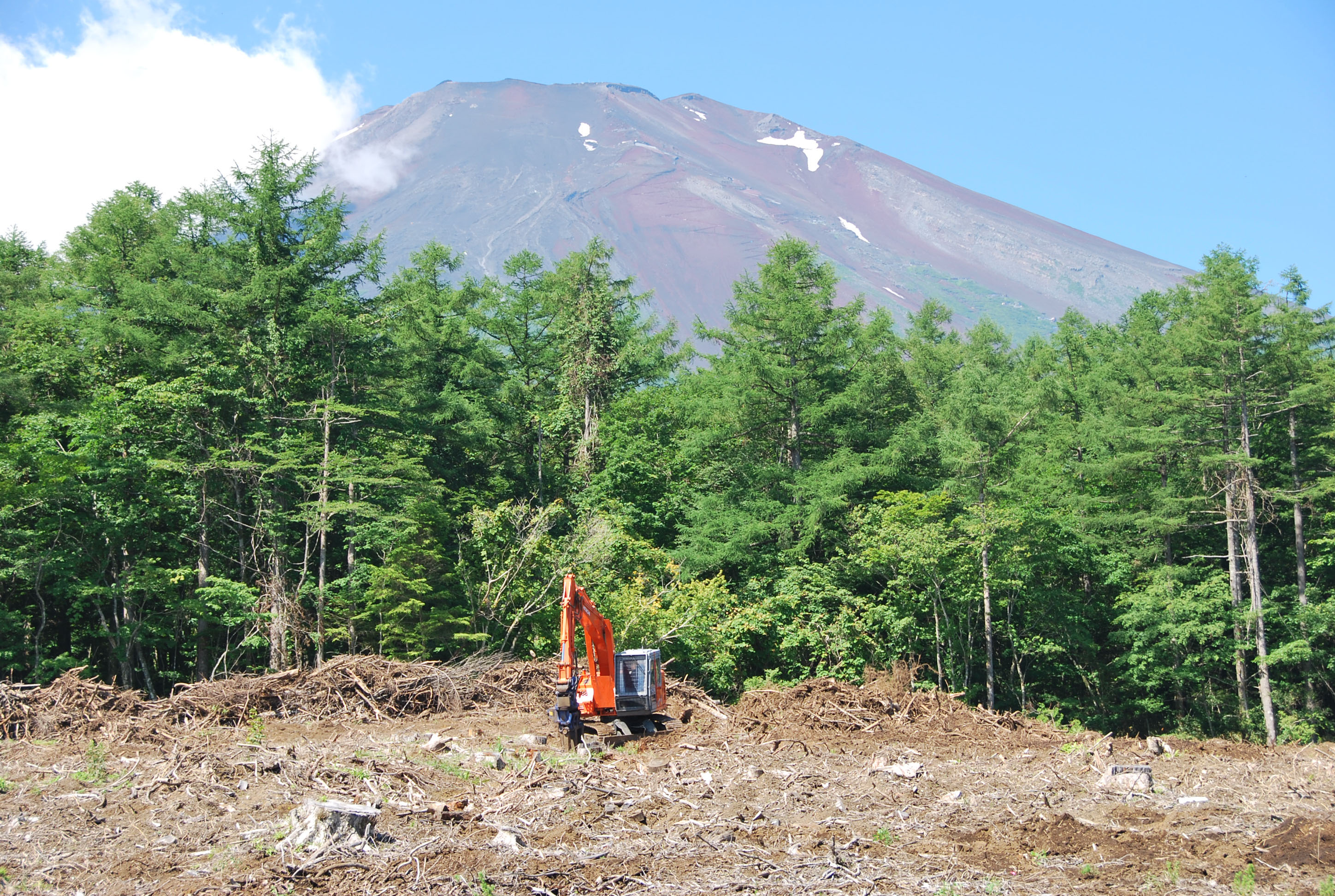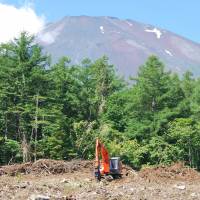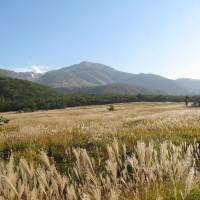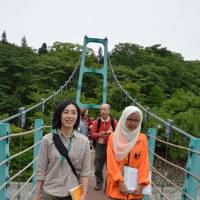Last month, just before the United Nations Educational, Scientific, and Cultural Organization announced Mount Fuji's designation as a World Cultural Heritage Site for its religious and artistic significance, 430 learned visitors descended on its lower northern slopes.
Dressed in saris and suits and with business cards bearing addresses from Pretoria to Amsterdam, the scholars, policy-makers and non-profit workers settled into a cluster of conference centers in the small Yamanashi Prefecture city of Fujiyoshida.
The group was not, however, focused on religious or artistic aspects of Mount Fuji, but on part of the iconic peak's cultural heritage that normally gets less attention: The fact that 8,151 hectares of the surrounding meadows and forests are managed collectively by residents of 11 local communities.
Scholars call this type of shared asset "commons" or "common-pool resources." An alternative to private or government control, the system of ownership has a very long history both in Japan and worldwide. Today, communities use it to govern access to fish, forests, water, language, music and lots else. The commons are shrinking, though, as corporate developers cordon off more and more for private profit.
Mount Fuji's recent multinational visitors had gathered to discuss these threats and many other topics at the weeklong 14th Global Conference of the International Association for the Study of the Commons (IASC). And for the first time in the group's 24-year history, they were meeting on actual commons.
"Thank you to the commoners for welcoming us to your spectacular home," said property-law scholar Michael Heller from Columbia University in New York City, during his keynote speech. As he voiced it, the oft-disdainful term "commoners" became a resounding honorific for those who share rights to — and responsibility for — the land.
But the commons and the commoners who use them have not always enjoyed such reverence. The most famous critique came from ecologist Garrett Hardin in a 1968 Science magazine article about overpopulation, "The Tragedy of the Commons."
Hardin argued that people who have unregulated access to shared resources will use them as much as they can, even though the resource will eventually be destroyed if all members of the community follow that same self-serving logic. For instance, a farmer gets all the benefits from putting another cow on the village commons, but only pays a fraction of the cost in terms of reduced grass per cow. So he adds more cows, and the cumulative result is overgrazing.
"Ruin is the destination toward which all men rush, each pursuing his own best interest in a society that believes in the freedom of the commons," Hardin wrote.
Heller's IASC speech was titled "The Tragedy of the Anticommons," and his point was that too much privatization is equally dangerous. One example: the River Rhine was a major trade route in the Middle Ages — until greedy barons crammed it with 200 toll bridges where they would levy taxes on its users. The river became impassable and "everyone suffered," Heller said.
More recently, virtual tollbooths in the form of patents on scientific understanding of how the brain works have stymied development of anti-Alzheimer's drugs.
That's not the only problem with arguing that commons lead to environmental tragedy while private ownership benefits everyone, said Ruth Meinzen-Dick, a senior research fellow at the International Food Policy Research Institute in Washington, and a former president of the IASC.
"This organization grew from efforts to refute that idea. Researchers had evidence that Hardin was just empirically wrong. People have maintained commons for 1,000 years in some cases," she said, adding that Hardin's paper refers only to situations with no regulation at all.
Such instances do exist, and some commons are overexploited (in Japan, overuse of forests created many hageyama —literally, "bald mountains" — before effective management systems evolved). Much more often, though, complex rules regulate how, when, by whom and to what extent resources may be used. In the district known as Kitafuji, where the IASC conference was held, farmers established rules related to forest and grassland use in the 16th or 17th century.
American political economist and IASC co-founder Elinor Ostrom was one scholar who fought back particularly vigorously against Hardin's theory. Drawing on both theory and field work, she argued that many communities have worked out frameworks for using commons that are sustainable and equitable. In 2009, Ostrom, who died last year, became the only female winner ever of a Nobel Memorial Prize in Economic Sciences — "for her analysis of economic governance, especially the commons."
Since Ostrom began her groundbreaking research in the 1980s, the field has expanded dramatically.
"The study of the commons has exploded in the past 10 years to include knowledge, climate change — the idea that air is a shared resource — and cultural history. It touches on a lot of our biggest challenges," said Daniel Niles, a geographer at the Research Institute for Humanity and Nature, in Kyoto, which helped organize the conference.
So just how much of the physical world can be called "commons"? Answers are hard to come by, partly because many communities lack formal rights to the woods, fishing grounds and grasslands they depend on.
According to Meinzen-Dick, more than 1.6 billion people actively use forest resources, often relying on them to survive poor harvests, climate disasters and the loss of wage labor. In India, she writes, poor families get up to 29 percent of their income from community forests; in Zimbabwe, reliance on commons is even higher. But governments or private entities often hold official title to these lands, and can profit from selling them off.
The Land Matrix, an online monitoring initiative, has documented large-scale land-acquisition deals covering 45 million hectares worldwide — roughly equivalent to the size of Sweden or Morocco. The government in Laos has granted foreign investors concessions to forests covering 5 percent of the country, which they convert to tree plantations, farms or mines. According to Aaron Russell of the Center for International Forestry Research, what's lost is often village commons.
"The government philosophy is to convert land to capital because it's all they have to sell. Part of the assumption is that these concessions will result in rural economic development. But they don't provide employment," said Russell, who presented his study of the situation at the IASC conference. "The government needs to recognize that all land in the village is in use and is economically important to people."
Japan's commons underwent their own wave of government seizure and privatization more than 100 years ago. Farmers around the country had set up systems for managing access to community forests and grasslands much earlier — around the 12th century, according to ecological economist Gaku Mitsumata, an associate professor at the University of Hyogo who is an expert on Japan's commons.
Those systems were strengthened in the feudal Edo Period (1603-1867) when Tokugawa shoguns ruled the nation and were dependent on rice as their tax base. Back then, about half of all forests and grasslands were commons (today, the figure is about 10 percent). Called iriaichi — a combination of the Japanese words for "enter," "meet" and "land" — these areas provided fuel, food and fodder, as well as leaves and brush vital for enriching paddy fields. In the Meiji Era (1868-1912), however, the government shifted from supporting the commons system to undermining it.
"The Meiji government wanted to modernize all things. To do that, they needed tax reform, so they tried to separate commons into private and government property (so more land was taxable). The government also wanted to take as much forest as possible under its control to establish plantation forests, in order to generate capital in the push for modernization," Mitsumata said.
Suddenly deprived of resources they needed for survival, villagers fought back. In Kitafuji, protests and lawsuits began around 1889, when the government confiscated the commons, and continued until the 1970s, when local residents finally regained strong rights to their land.
By then, though, Japan's Self-Defense Forces had taken over half the area for military use. The SDF and U.S. forces still occupy that land today — but to do so, they must now pay ¥1.6 billion a year to the Onshirin Regional Public Organization, the commons management body.
Mitsumata says those payments are in exchange for decades of sacrifice imposed on Kitafuji residents — but he worries the nature of the commons has been changed.
"The commons is embedded with land use, especially for agriculture. But in Kitafuji they have become like a huge pocket for generating money. The commoners need to work with other stakeholders to think about increasing utilization of the land," he said.
Male dominance of management decisions is another problem commoners throughout Japan should address, he added.
Those problems barely surfaced in the ceremonies, cultural events and tours the Kitafuji commoners offered up for their scholarly visitors. Below the celebratory surface, however, the message was clear: Japan's commons, like those around the world, face a future that is far from certain.




















With your current subscription plan you can comment on stories. However, before writing your first comment, please create a display name in the Profile section of your subscriber account page.